A Mononuclear Iron(II) Spin-Crossover Molecule Decorated by Photochromic Azobenzene Group
Abstract
:1. Introduction
2. Results
2.1. Magnetic Properties
2.2. Structural Characterization
2.3. 57Fe Mössbauer Spectra
2.4. Photo-Isomerization Study for Abtz and 1 in Solution
2.5. Magnetism Study for 1 in Solution Phase
2.6. Photo-Isomerization Study for Abtz and 1 in Solid
3. Materials and Methods
3.1. General Remarks
3.2. Crystal Structure Determination
3.3. Synthesis of Abtz
3.4. Synthesis of Fe(Abtz)3
4. Conclusions
Supplementary Materials
Author Contributions
Funding
Institutional Review Board Statement
Informed Consent Statement
Data Availability Statement
Conflicts of Interest
Sample Availability
References
- Halcrow, M.A. Structure:function relationships in molecular spin-crossover complexes. Chem. Soc. Rev. 2011, 40, 4119–4142. [Google Scholar] [CrossRef] [PubMed]
- Halcrow, M.A. Trapping and manipulating excited spin states of transition metal compounds. Chem. Soc. Rev. 2008, 37, 278–289. [Google Scholar] [CrossRef] [PubMed]
- Létard, J.-F. Photomagnetism of iron(ii) spin crossover complexes—The T(LIESST) approach. J. Mater. Chem. 2006, 16, 2550–2559. [Google Scholar] [CrossRef]
- Halcrow, M.A. Iron(II) complexes of 2,6-di(pyrazol-1-yl)pyridines—A versatile system for spin-crossover research. Coord. Chem. Rev. 2009, 253, 2493–2514. [Google Scholar] [CrossRef]
- Muñoz, M.C.; Real, J.A. Thermo-, piezo-, photo- and chemo-switchable spin crossover iron(II)-metallocyanate based coordination polymers. Coord. Chem. Rev. 2011, 255, 2068–2093. [Google Scholar] [CrossRef]
- Ni, Z.-P.; Liu, J.-L.; Hoque, N.; Liu, W.; Li, J.-Y.; Chen, Y.-C.; Tong, M.-L. Recent advances in guest effects on spin-crossover behavior in Hofmann-type metal-organic frameworks. Coord. Chem. Rev. 2017, 335, 28–43. [Google Scholar] [CrossRef]
- Ohkoshi, S.-I.; Takano, S.; Imoto, K.; Yoshikiyo, M.; Namai, A.; Tokoro, H. 90-degree optical switching of output second-harmonic light in chiral photomagnet. Nat. Photon. 2013, 8, 65–71. [Google Scholar] [CrossRef]
- Ohkoshi, S.-I.; Imoto, K.; Tsunobuchi, Y.; Takano, S.; Tokoro, H. Light-induced spin-crossover magnet. Nat. Chem. 2011, 3, 564–569. [Google Scholar] [CrossRef]
- Chen, Y.-C.; Meng, Y.; Ni, Z.-P.; Tong, M.-L. Synergistic electrical bistability in a conductive spin crossover heterostructure. J. Mater. Chem. C 2015, 3, 945–949. [Google Scholar] [CrossRef]
- Phan, H.; Benjamin, S.M.; Steven, E.; Brooks, J.S.; Shatruk, M. Photomagnetic response in highly conductive iron(II) spin-crossover complexes with TCNQ radicals. Angew. Chem. Int. Ed. 2015, 54, 823–827. [Google Scholar] [CrossRef]
- Rubio-Gimenez, V.; Tatay, S.; Marti-Gastaldo, C. Electrical conductivity and magnetic bistability in metal-organic frameworks and coordination polymers: Charge transport and spin crossover at the nanoscale. Chem. Soc. Rev. 2020, 49, 5601–5638. [Google Scholar] [CrossRef] [PubMed]
- Li, X.-M.; Dong, L.-Z.; Liu, J.; Ji, W.-X.; Li, S.-L.; Lan, Y.-Q. Intermediate-Temperature Anhydrous High Proton Conductivity Triggered by Dynamic Molecular Migration in Trinuclear Cluster Lattice. Chem 2020, 6, 2272–2282. [Google Scholar] [CrossRef]
- Shepherd, H.; Gural’Skiy, I.A.; Quintero, C.M.; Tricard, S.; Salmon, L.; Molnar, G.; Bousseksou, A. Molecular actuators driven by cooperative spin-state switching. Nat. Commun. 2013, 4, 2607. [Google Scholar] [CrossRef] [PubMed] [Green Version]
- Hauser, A.; Jeftić, J.; Romstedt, H.; Hinek, R.; Spiering, H. Cooperative phenomena and light-induced bistability in iron(II) spin-crossover compounds. Coord. Chem. Rev. 1999, 190–192, 471–491. [Google Scholar] [CrossRef] [Green Version]
- Thompson, J.R.; Archer, R.J.; Hawes, C.S.; Archer, A.; Wattiaux, A.; Mathonière, C.; Clérac, R.; Kruger, P.E. Thermally and photo-induced spin crossover behaviour in an Fe(ii) imidazolylimine complex: [FeL3](ClO4)2. Dalton Trans. 2012, 41, 12720–12725. [Google Scholar] [CrossRef]
- Boillot, M.-L.; Roux, C.; Audière, J.-P.; Dausse, A.; Zarembowitch, J. Ligand-Driven Light-Induced Spin Change in Transition-Metal Complexes: Selection of an Appropriate System and First Evidence of the Effect, in FeII(4-styrylpyridine)4(NCBPh3)2. Inorg. Chem. 1996, 35, 3975–3980. [Google Scholar] [CrossRef]
- Roux, C.; Zarembowitch, J.; Gallois, B.; Granier, T.; Claude, R. Toward Ligand-Driven Light-Induced Spin Changing. Influence of the Configuration of 4 Styrylpyridine (stpy) on the Magnetic Properties of FeII(stpy)4(NCS)2 Complexes. Crystal Structures of the Spin-Crossover Species Fe(trans-stpy)4(NCS)2 and of the High-Spin Species Fe(cis-stpy)4(NCS)2. Inorg. Chem. 1994, 33, 2273–2279. [Google Scholar] [CrossRef]
- Boillot, M.-L.; Pillet, S.; Tissot, A.; Rivière, E.; Claiser, N.; Lecomte, C. Ligand-Driven Light-Induced Spin Change Activity and Bidirectional Photomagnetism of Styrylpyridine Iron(II) Complexes in Polymeric Media. Inorg. Chem. 2009, 48, 4729–4736. [Google Scholar] [CrossRef]
- Takahashi, K.; Hasegawa, Y.; Sakamoto, R.; Nishikawa, M.; Kume, S.; Nishibori, E.; Nishihara, H. Solid-State Ligand-Driven Light-Induced Spin Change at Ambient Temperatures in Bis(dipyrazolylstyrylpyridine)iron(II) Complexes. Inorg. Chem. 2012, 51, 5188–5198. [Google Scholar] [CrossRef]
- Hasegawa, Y.; Kume, S.; Nishihara, H. Reversible light-induced magnetization change in an azobenzene-attached pyridylbenzimidazole complex of iron(ii) at room temperature. Dalton Trans. 2009, 280–284. [Google Scholar] [CrossRef]
- Milek, M.; Heinemann, F.W.; Khusniyarov, M.M. Spin Crossover Meets Diarylethenes: Efficient Photoswitching of Magnetic Properties in Solution at Room Temperature. Inorg. Chem. 2013, 52, 11585–11592. [Google Scholar] [CrossRef] [PubMed]
- Sénéchal-David, K.; Zaman, N.; Walko, M.; Halza, E.; Rivière, E.; Guillot, R.; Feringa, B.L.; Boillot, M.-L. Combining organic photochromism with inorganic paramagnetism—optical tuning of the iron(ii) electronic structure. Dalton Trans. 2008, 1932–1936. [Google Scholar] [CrossRef] [PubMed]
- Rösner, B.; Milek, M.; Witt, A.; Gobaut, B.; Torelli, P.; Fink, R.H.; Khusniyarov, M.M. Reversible Photoswitching of a Spin-Crossover Molecular Complex in the Solid State at Room Temperature. Angew. Chem. Int. Ed. 2015, 54, 12976–12980. [Google Scholar] [CrossRef] [PubMed]
- Estrader, M.; Salinas Uber, J.; Barrios, L.A.; Garcia, J.; Lloyd-Williams, P.; Roubeau, O.; Teat, S.J.; Aromi, G. A Magneto-optical Molecular Device: Interplay of Spin Crossover, Luminescence, Photomagnetism, and Photochromism. Angew. Chem. Int. Ed. 2017, 56, 15622–15627. [Google Scholar] [CrossRef] [Green Version]
- Wang, L.-F.; Zhuang, W.-M.; Huang, G.-Z.; Chen, Y.-C.; Qiu, J.-Z.; Ni, Z.-P.; Tong, M.-L. Spin-crossover modulation via single-crystal to single-crystal photochemical [2 + 2] reaction in Hofmann-type frameworks. Chem. Sci. 2019, 10, 7496–7502. [Google Scholar] [CrossRef] [Green Version]
- Wang, L.-F.; Lv, B.-H.; Wu, F.-T.; Huang, G.-Z.; Ruan, Z.-Y.; Chen, Y.-C.; Liu, M.; Ni, Z.-P.; Tong, M.-L. Reversible on-off switching of spin-crossover behavior via photochemical [2 + 2] cycloaddition reaction. Sci. China Ser. B Chem. 2022, 65, 120–127. [Google Scholar] [CrossRef]
- Xie, K.P.; Ruan, Z.Y.; Lyu, B.H.; Chen, X.X.; Zhang, X.W.; Huang, G.Z.; Chen, Y.C.; Ni, Z.P.; Tong, M.L. Guest-Driven Light-Induced Spin Change in an Azobenzene Loaded Metal-Organic Framework. Angew. Chem. Int. Ed. 2021, 60, 27144–27150. [Google Scholar] [CrossRef]
- McKinnon, J.J.; Spackman, M.A.; Mitchell, A.S. Novel tools for visualizing and exploring intermolecular interactions in molecular crystals. Acta Crystallogr. Sect. B Struct. Sci. 2004, 60 Pt 6, 627–668. [Google Scholar] [CrossRef]
- Evans, D.F. The determination of the paramagnetic susceptibility of substances in solution by nuclear magnetic resonance. J. Chem. Soc. 1959, 2003–2005. [Google Scholar] [CrossRef]
- Bain, G.A.; Berry, J.F. Diamagnetic Corrections and Pascal’s Constants. J. Chem. Educ. 2008, 85, 532. [Google Scholar] [CrossRef]
- Duarte, L.; Fausto, R.; Reva, I. Structural and spectroscopic characterization of E- and Z-isomers of azobenzene. Phys. Chem. Chem. Phys. 2014, 16, 16919–16930. [Google Scholar] [CrossRef] [PubMed]
- Hoffmann, K.; Resch-Genger, U.; Marlow, F. Photoinduced switching of nanocomposites consisting of azobenzene and molecular sieves: Investigation of the switching states. Microporous Mesoporous Mater. 2000, 41, 99–106. [Google Scholar] [CrossRef]
- Jiang, Y.; Park, J.; Tan, P.; Feng, L.; Liu, X.-Q.; Sun, L.-B.; Zhou, H.-C. Maximizing Photoresponsive Efficiency by Isolating Metal–Organic Polyhedra into Confined Nanoscaled Spaces. J. Am. Chem. Soc. 2019, 141, 8221–8227. [Google Scholar] [CrossRef] [PubMed]
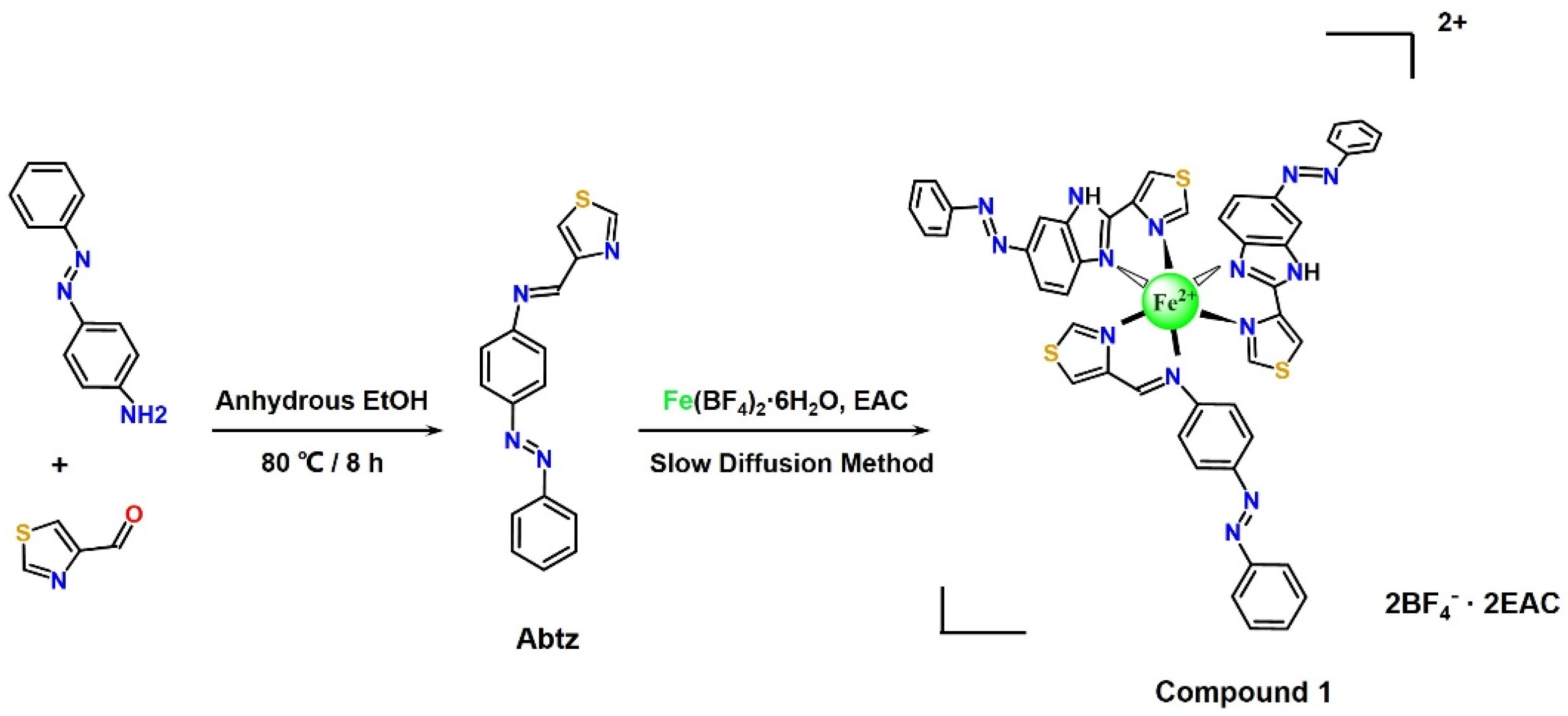
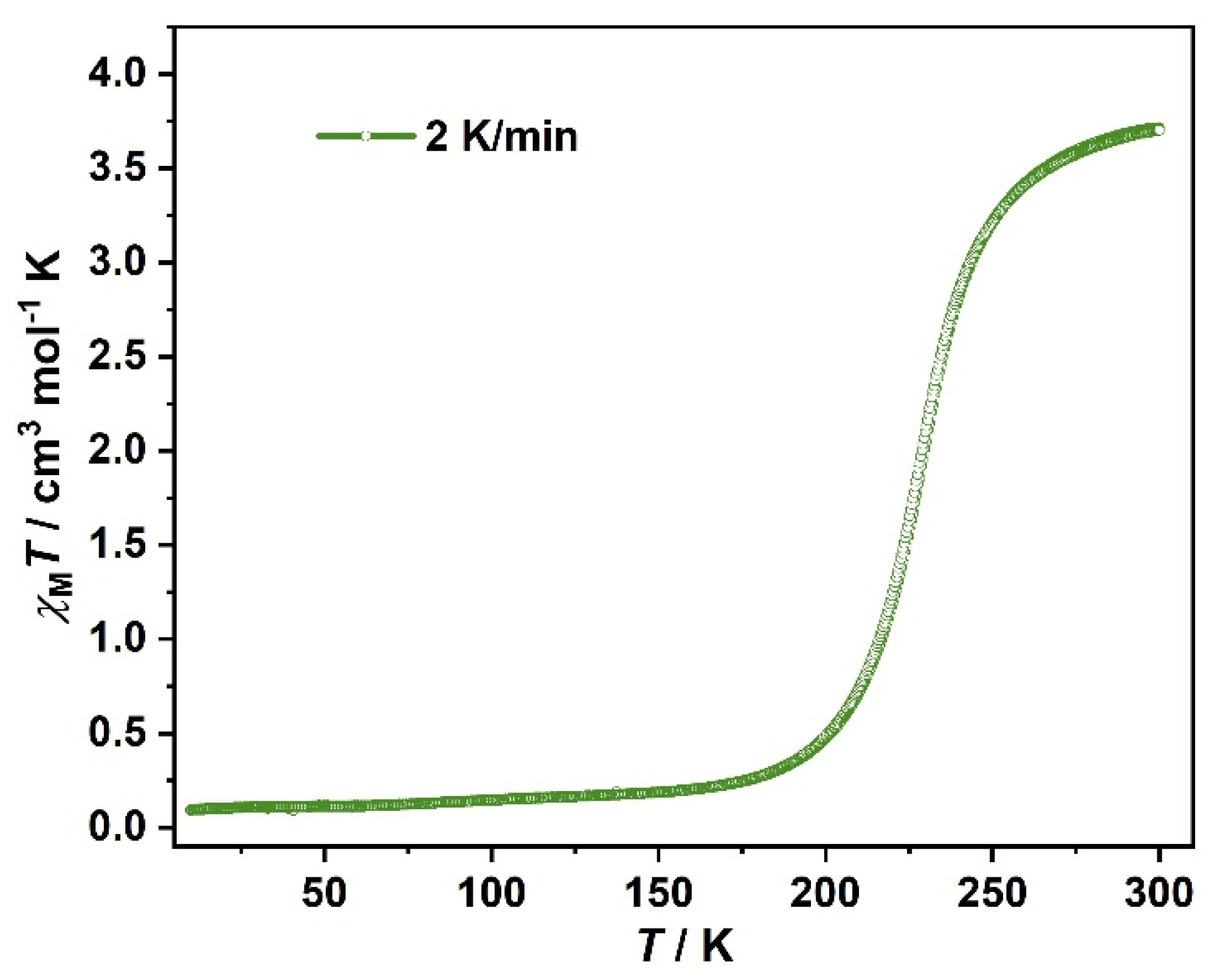
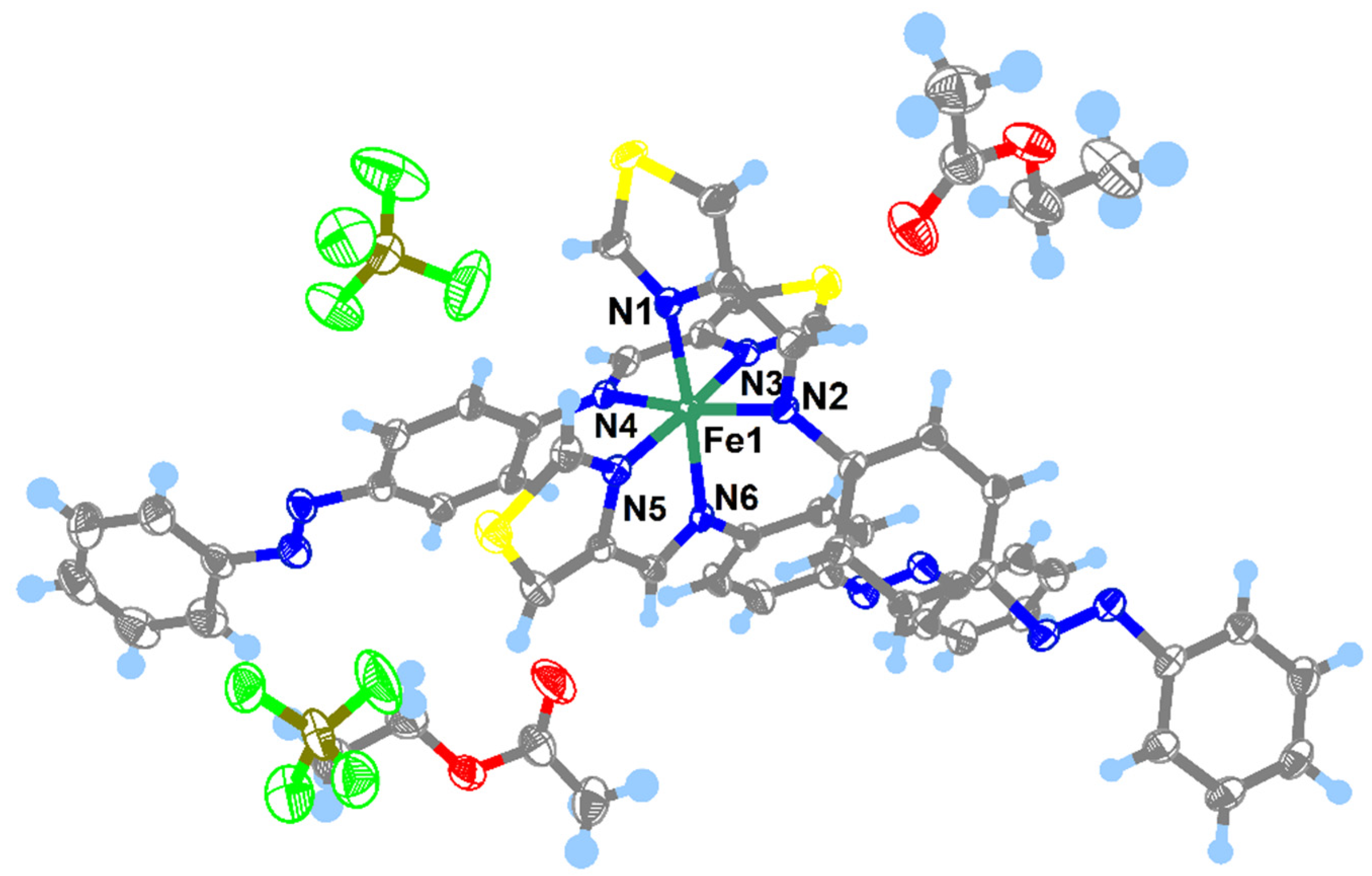
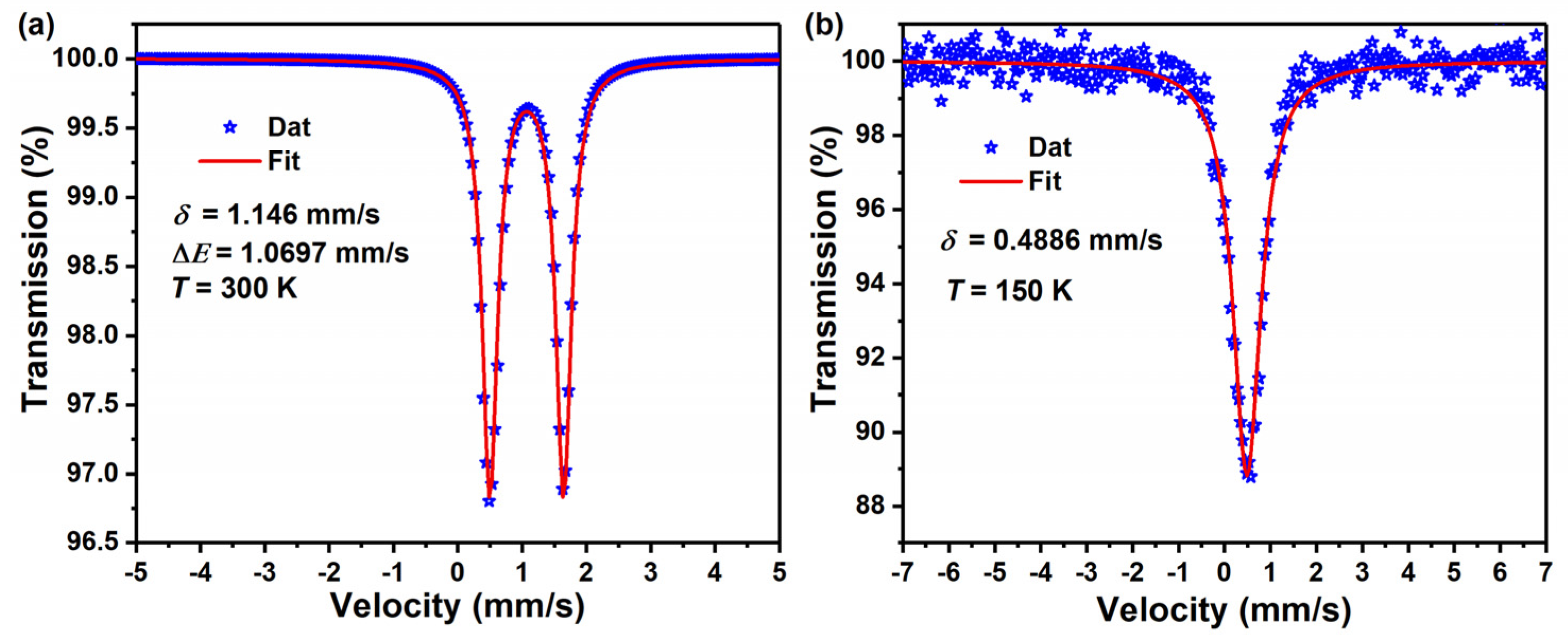

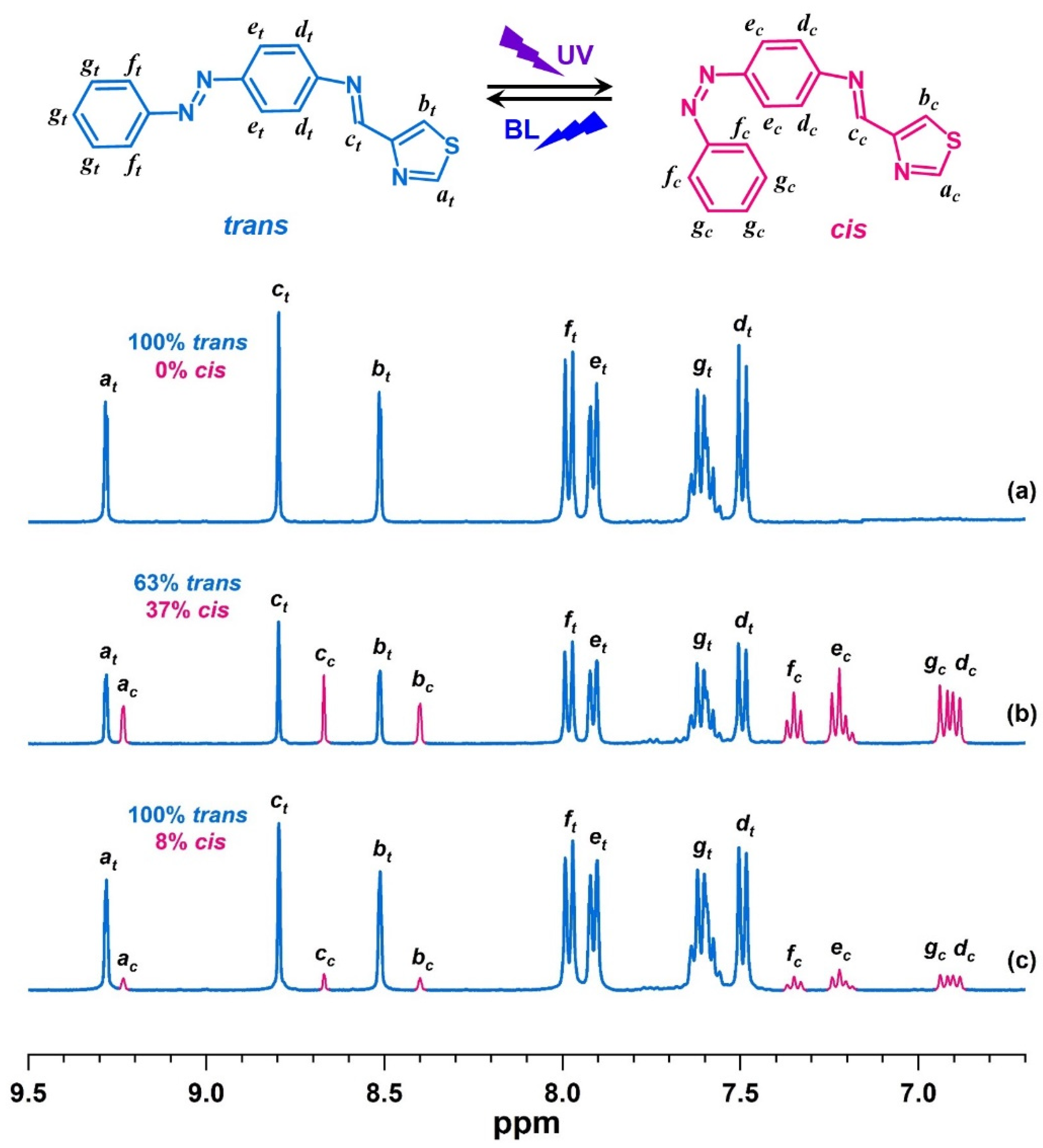
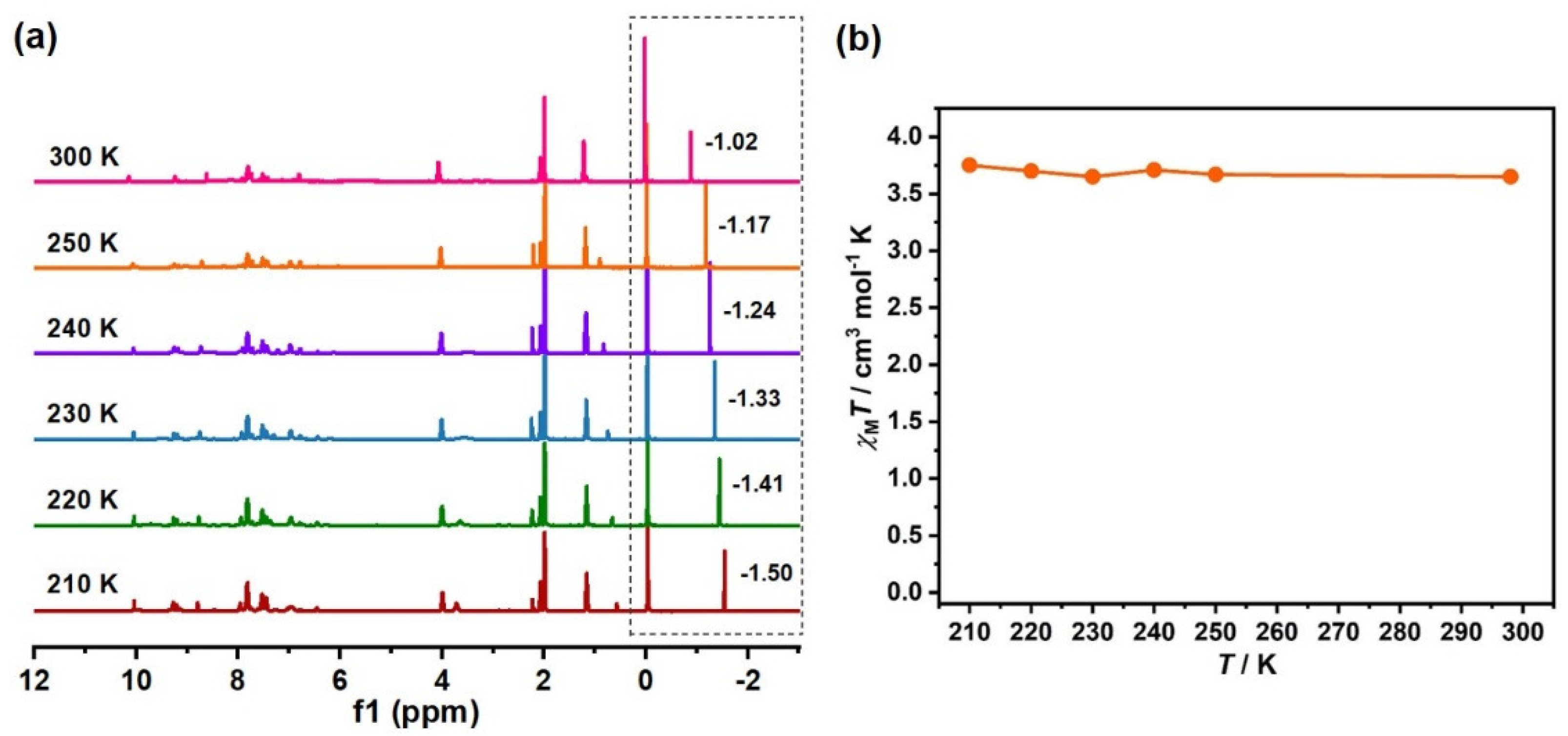
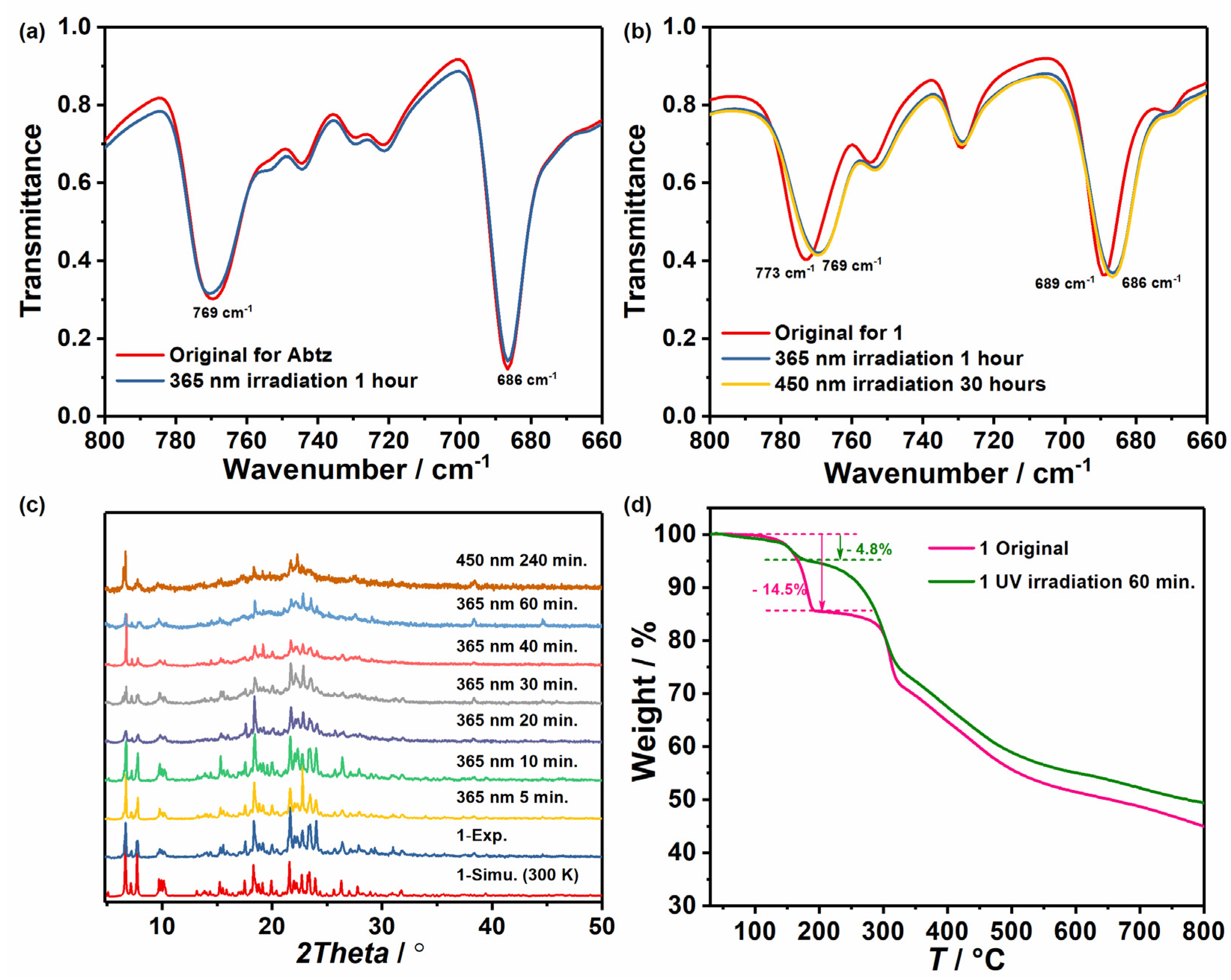
| Bond Lengths/Å | 150 K | 229 K | 300 K |
|---|---|---|---|
| Fe-N1 | 1.977(2) | 2.067(3) | 2.178(4) |
| Fe-N2 | 2.004(2) | 2.096(3) | 2.199(4) |
| Fe-N3 | 1.982(2) | 2.067(3) | 2.160(4) |
| Fe-N4 | 2.016(2) | 2.130(3) | 2.252(4) |
| Fe-N5 | 1.960(2) | 2.035(3) | 2.116(4) |
| Fe-N6 | 2.040(2) | 2.134(3) | 2.242(4) |
| <Fe–N> a | 1.997 | 2.091 | 2.191 |
Publisher’s Note: MDPI stays neutral with regard to jurisdictional claims in published maps and institutional affiliations. |
© 2022 by the authors. Licensee MDPI, Basel, Switzerland. This article is an open access article distributed under the terms and conditions of the Creative Commons Attribution (CC BY) license (https://creativecommons.org/licenses/by/4.0/).
Share and Cite
Qiu, J.-Z.; You, Y.; Yu, Y.; Chen, Z.-F.; Guo, C.-J.; Zhong, Y.-L.; Lin, W.-Q.; Shu, X.-G. A Mononuclear Iron(II) Spin-Crossover Molecule Decorated by Photochromic Azobenzene Group. Molecules 2022, 27, 1571. https://doi.org/10.3390/molecules27051571
Qiu J-Z, You Y, Yu Y, Chen Z-F, Guo C-J, Zhong Y-L, Lin W-Q, Shu X-G. A Mononuclear Iron(II) Spin-Crossover Molecule Decorated by Photochromic Azobenzene Group. Molecules. 2022; 27(5):1571. https://doi.org/10.3390/molecules27051571
Chicago/Turabian StyleQiu, Jiang-Zhen, Yong You, Ye Yu, Zhuo-Fan Chen, Cheng-Jie Guo, Yi-Ling Zhong, Wei-Quan Lin, and Xu-Gang Shu. 2022. "A Mononuclear Iron(II) Spin-Crossover Molecule Decorated by Photochromic Azobenzene Group" Molecules 27, no. 5: 1571. https://doi.org/10.3390/molecules27051571
APA StyleQiu, J.-Z., You, Y., Yu, Y., Chen, Z.-F., Guo, C.-J., Zhong, Y.-L., Lin, W.-Q., & Shu, X.-G. (2022). A Mononuclear Iron(II) Spin-Crossover Molecule Decorated by Photochromic Azobenzene Group. Molecules, 27(5), 1571. https://doi.org/10.3390/molecules27051571






